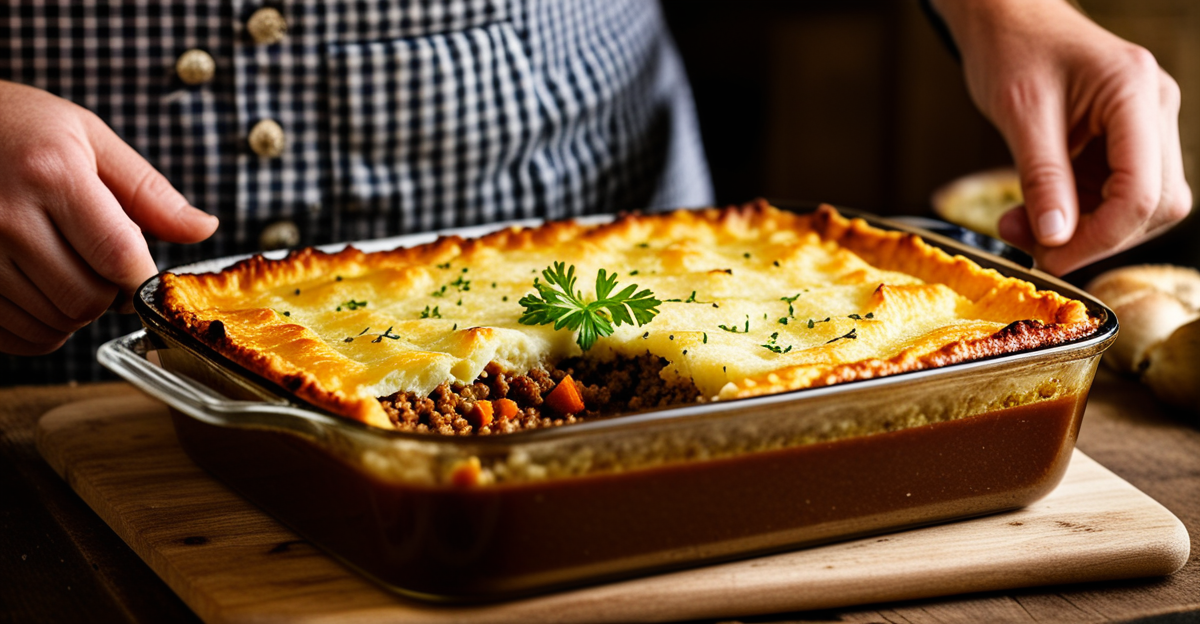Key steps for assembling an exceptional cottage pie
Mastering cottage pie preparation involves careful attention to the assembly process, as it’s the synergy of layers and ingredients that defines the dish’s character. Start with selecting quality meats and vegetables—opt for tender cuts like minced beef with a good fat ratio, and fresh, firm vegetables such as carrots and onions to ensure vibrant flavor and texture.
When preparing the filling, use best practices by seasoning well and cooking it slowly for depth. Incorporate aromatic herbs like thyme or rosemary alongside a splash of stock to create a savory base. This seasoning blend is essential to enhance the natural flavors of the ingredients without overpowering them.
Have you seen this : What are the best tips for making a traditional English breakfast?
For assembly, focus on layering ingredients thoughtfully. Spread the filling evenly in the base of your baking dish to avoid sogginess and ensure every bite is flavorful. Top the filling with a generous layer of creamy mashed potatoes, smoothing it out but leaving texture for a visually appealing golden crust after baking.
Balancing the texture is critical: the filling should be moist yet not watery, while the potato topping should be fluffy but firm enough to hold its shape once baked. These assembly steps are vital to crafting an authentic and satisfying cottage pie.
Also to discover : How can you prepare a mouth-watering steak and kidney pie at home?
Ingredient selection and seasoning essentials
Choosing the right cottage pie ingredients is fundamental. For potatoes, starchy varieties like Russet or Maris Piper yield fluffy mash, ideal for a creamy topping. When selecting meat, opt for minced cuts with a balanced fat content, such as chuck or brisket mince, which provide rich flavor and tenderness during slow cooking.
Seasoning plays a pivotal role. Use stock, preferably homemade beef or vegetable, to intensify the filling’s depth. Aromatics like onions, garlic, and celery are essential for layering flavor profiles. Add herbs such as thyme or rosemary early in the cooking process to allow their aromas to infuse the filling fully.
Balancing seasoning is crucial to avoid a bland pie. Salt enhances the natural flavors, but over-salting risks overpowering the dish. Pepper adds a subtle heat and depth, while a splash of Worcestershire sauce or tomato paste can introduce umami notes, elevating the richness without complicating the natural taste of the cottage pie ingredients.
In summary, effective seasoning tips involve layering flavors carefully, choosing hearty ingredients, and enhancing without overwhelming—this ensures a well-rounded savory flavor fundamental to exceptional cottage pie preparation.
Techniques for perfect layering and texture
Achieving flawless cottage pie layering starts with an even, well-distributed filling. To prevent a watery pie, drain any excess liquid from the cooked meat and vegetables before placing them in the dish. This ensures the filling stays moist but not soggy, maintaining structural integrity. Spread the filling uniformly to guarantee balanced flavor in every bite.
For the topping, a creamy, smooth mashed potato layer is essential. Use starchy potatoes like Maris Piper or Yukon Gold for fluffiness, and mash them thoroughly with butter and cream until silky but firm enough to spread without running. When layering, gently smooth the potatoes over the filling but retain subtle peaks or ridges. These create an attractive golden crust when baked.
Maintaining proper texture involves timing and portion control. Avoid overcrowding the dish, which can cause uneven cooking layers. A well-layered cottage pie boasts a harmonious contrast: tender, richly seasoned filling beneath a light, crisp-topped mashed potato layer. Remember, precise layering and attention to moisture are key assembly techniques that elevate your cottage pie from ordinary to exceptional.
Key steps for assembling an exceptional cottage pie
Effective cottage pie preparation hinges on precise layering and ingredient quality. Start by selecting fresh, high-quality ingredients — choose minced beef with a balance of lean meat and fat for juiciness, and robust vegetables like carrots and onions for texture and taste. This foundation supports a well-rounded filling.
When preparing the filling, seasoning is key. Use best practices such as slow cooking the meat to develop richness and incorporating herbs like thyme. A well-seasoned filling is moist but not watery, crucial to avoid a soggy pie. Stir in stock gradually to maintain the right consistency.
In assembly, spread the filling evenly to cover the dish’s base. This ensures uniform cooking and flavour in every bite. Next, add a thick layer of creamy mashed potatoes, smoothing but keeping some texture to encourage browning during baking. Proper assembly techniques balance moisture and texture, resulting in a golden, crispy top with a flavorful, moist interior.
Following these steps in cottage pie preparation—quality ingredients, deliberate seasoning, and careful layering—creates an authentic, satisfying dish that stands out in both taste and appearance.
Key steps for assembling an exceptional cottage pie
Successful cottage pie preparation hinges on meticulous assembly to balance flavors and textures perfectly. Start by selecting prime ingredients—choose minced beef cuts with adequate fat for richness and fresh vegetables like onions and carrots that add both sweetness and bite. These choices directly affect the final flavor and mouthfeel.
When cooking the filling, apply best practices: brown the meat thoroughly to develop a deep, savory base, then simmer it slowly with vegetables, herbs, and stock to meld flavors. Season thoughtfully to avoid overpowering the natural taste, keeping the balance as highlighted in earlier seasoning tips.
During assembly, spread the filling evenly across your dish to prevent sogginess while ensuring every bite bursts with flavor. Next, top with a thick, creamy layer of mashed potatoes. Smooth the surface but maintain subtle peaks—this texture detail encourages a beautiful golden crust throughout baking.
Precision in layering impacts both moisture control and bite experience. An even filling layer beneath an airy potato topping creates a harmonious contrast, making the assembly not just a step in preparation but a critical art form that elevates a cottage pie to exceptional status.
Key steps for assembling an exceptional cottage pie
Start cottage pie preparation by selecting quality meats and vegetables that complement each other for optimal flavor. Choose minced beef with balanced fat content, such as chuck mince, to ensure juiciness and tenderness. Fresh vegetables like carrots and onions add texture and enhance the overall taste. Proper ingredient selection avoids a bland or overly greasy filling.
When preparing the filling, best practices include thoroughly seasoning with herbs like thyme or rosemary and adding stock slowly during cooking. This approach deepens the savory flavor while maintaining a moist, not overly wet, consistency. Cooking the filling on low heat allows flavors to meld and the meat to become tender.
Assemble the pie by spreading the filling evenly to create a uniform base, avoiding gaps that could cause uneven cooking. Follow with a thick layer of creamy mashed potatoes, gently smoothing but leaving slight peaks to encourage a golden crust. This balance of layers ensures contrasting textures—a rich, flavorful filling beneath a crisp, fluffy topping.
Consistently applying these steps in cottage pie preparation maximizes flavor and texture harmony, producing a satisfying dish that meets traditional expectations and delights the palate.
Key steps for assembling an exceptional cottage pie
Careful selection of ingredients is foundational in cottage pie preparation. Choose minced beef with a balanced fat content to ensure a juicy filling. Fresh vegetables like onions and carrots contribute essential sweetness and texture. Properly prepared, these ingredients form the base of a flavorful filling.
Use best practices when cooking: brown the meat thoroughly to develop rich umami flavors, then simmer slowly with vegetables, herbs, and stock to deepen complexity. Season intentionally but sparingly, reinforcing natural flavors without overwhelming them.
Assembly demands precise layering for ideal texture and taste. Spread the filling evenly across your baking dish to avoid sogginess and ensure consistent flavour distribution. The mashed potato topping should be thick and creamy; smooth it but leave subtle ridges to foster a golden, crispy crust during baking. This layering balances moisture and texture, creating contrast between the tender filling and crisp potato topping.
In sum, successful cottage pie preparation involves selecting quality ingredients, applying sound cooking methods, and mastering assembly. These steps together build a dish with depth of flavour and satisfying texture, reflecting the art of crafting an exceptional cottage pie.
Key steps for assembling an exceptional cottage pie
Effective cottage pie preparation begins with selecting quality ingredients. Opt for minced beef with the right fat content to ensure juiciness and flavor. Fresh vegetables like carrots and onions enhance texture and sweetness, complementing the savory filling. Choosing the correct ingredients sets the foundation for a balanced pie.
When preparing the filling, apply best practices such as slow cooking and gradual seasoning. Browning the meat thoroughly releases rich flavours, while adding stock in controlled amounts maintains ideal moisture. Herbs like thyme infuse aroma, and seasoning is layered carefully to avoid overpowering the filling’s natural taste.
Proper assembly is crucial. Spread the filling evenly across the baking dish to avoid gaps and ensure uniform cooking. Top with a thick layer of creamy mashed potatoes, smoothing gently but leaving small peaks. These ridges promote a crisp, golden crust during baking. The assembly balances moist filling and fluffy topping, delivering contrasting textures that define a well-made cottage pie.
Following these key steps in cottage pie preparation—selecting ingredients judiciously, seasoning thoughtfully, and layering precisely—elevates the dish’s depth, texture, and overall enjoyment.
Key steps for assembling an exceptional cottage pie
Selecting the right ingredients is vital in cottage pie preparation. Opt for minced beef with a good fat ratio to keep the filling juicy. Fresh vegetables like onions and carrots contribute texture and subtle sweetness that complement the meat. This selection lays the foundation for a richly flavored filling.
When preparing the filling, applying best practices means browning the meat thoroughly to develop depth through caramelization. Slowly simmer the mixture with herbs such as thyme and a splash of stock, enhancing savory notes without overwhelming. Proper seasoning here avoids blandness and ensures a well-balanced taste.
During assembly, even distribution of the filling prevents sogginess and guarantees consistent flavor in every bite. Spread the filling to cover the base uniformly, then add a thick, creamy layer of mashed potatoes. Smooth gently but leave small ridges or peaks; this encourages a golden, crisp crust when baked. Balancing textures between the moist filling and fluffy topping is key.
These assembly steps—careful ingredient selection, seasoned filling preparation, and precise layering—form the core of exceptional cottage pie preparation, delivering an ideal marriage of flavor and texture in the final dish.










